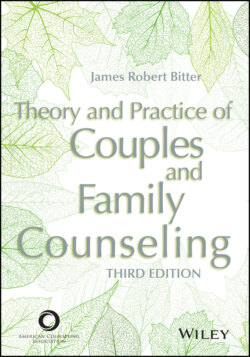Читать книгу Theory and Practice of Couples and Family Counseling - James Robert Bitter - Страница 84
Gender and Multicultural Lenses
ОглавлениеBecause the early years of family counseling almost completely ignored the lenses of gender and culture, I believe that it is important to highlight these perspectives here. Like other institutions and practices in society, family counseling has all too often reflected and supported the dominant value system, ignoring the effects of oppression based on class, race, ethnicity, gender and gender identity, health/ability, religion, and sexual and affectional orientation. The very definition of family in the United States is based on a nuclear, middle-class family that is White, of mixed-European cultures, Protestant, healthy and able, and heterosexual; the father is an “absent” breadwinner and the mother stays at home raising two children (preferably one of each of only two genders, with the oldest being male). This description accounts for only 3% of the actual population in the United States (McGoldrick & Hardy, 2019). It is also an ideal that has not served women well, rendering the “mother … perpetually on call for everyone emotionally and physically” (p. 6). It is a patriarchal arrangement that reinforces gender stereotypes while minimizing or eliminating much-needed alternatives for the other 97% of the population.
Race, class, ethnicity, culture, gender, health and ability, and sexual and affectional orientation are dynamic parts of individuals and family systems. To know ourselves as individuals and family practitioners requires that we investigate our families of origin for the cultural experiences that relate to these dynamics. Before we can know the richness and diversity of other families, we must come to know our own heritage. Whether we are part of the dominant culture or of one or more marginalized cultures, both our values and our families have been organized in ways that shape these meanings in our lives.
Of all the discriminations people face in the world, sexism and the oppression of women are the oldest and most pervasive. Indeed, one of the most difficult aspects of working with multicultural families is balancing the need to be sensitive and appreciative of cultural differences when those differences still involve discrimination against women. Still, no society or culture lacks feminist voices. In the first decades of the 21st century, we have truly become a global village: Television and mass communication are joining people across borders. Women all over the world are supporting one another in their acquisition of freedom and equality.
What meanings do you attach to being male or female or some other gender identity? What pronouns are appropriate for you? What is your cultural heritage? How did these perspectives shape your life when you were young, and how do they shape it now? Who benefits from the definitions you attach to gender and culture? Who is privileged by these definitions? Who is marginalized? If you were going to make a special effort to be sensitive to and appreciate diversity, how would that effort affect your family practice? How would it affect your role with others? How would your words reflect your sensitivity and appreciation?
Because gender and cultural perspectives are so important to the field today, I give special consideration to these lenses at the end of each theory chapter—in addition to considering the lenses in more detail in Chapter 18 on integration. The most effective models and practitioners tailor their approach to fit the unique needs of families with a wide range of structures, cultures, economics, and genders. Family practitioners today are required to possess knowledge for working with various cultures and are called to a personal and professional consideration of their own gender heritage and cultural experiences. In an effort to prevent harm, they must learn the culturally sensitive skills needed to assist families with the realities of their individual cultures.
